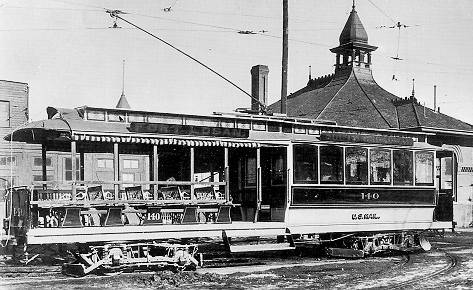Woeber Brothers Carriage Co.
Adam Woeber (18__ -1876+)—the third son—joined the business, and in 1867 went to Denver, in Colorado Territory, where he set up shop with capital supplied by Amandus. He called this business A. Woeber & Company. ("A" for Amandus? Or for Adam?) Gallus either went with him or soon followed and the business became Woeber Brothers Carriage Works. The initial works was on 11th Street between Wazee and Walnut Streets. The Woeber brothers built everything from clunky ore wagons to the finest of carriages prized by Denver’s elite, but apparently their specialty was commercial wagons, including the ore wagons, delivery vans and wagons, and later, omnibuses. After Gallus died, in 1875, his son Charles William (c.1859-1888+) became associated with the business. The Denver City Directory for 1876 shows —
It appears the Woebers first built cars for railways about 1884, when they delivered six diminutive horse cars to the Denver City Railway Company for use on its Broadway extension. Robertson {61} suggests they were persuaded to do so by the General Manager of that railroad who wanted to save the high freight charges incident to cars manufactured by eastern builders. He says about these cars —
In ensuing years, as Denver expanded and its street railways multiplied, spread ever more widely, and underwent technological changes in propulsion—from horse to cable (yes, Denver did have cable cars) to electric—virtually every announcement appears to have contained the phrase ‘... cars have been ordered from the Woeber Carriage Company.’ About 1889/90, Woeber built a new plant specifically for the purpose of building streetcars, their 11th Street building(s) no doubt having proved too restrictive. That facility would henceforth be devoted to carriage and wagon construction. The new plant occupied five acres at the junction of South Bannock Street and West Colorado Avenue. Adam’s son Rudolph ( - ) became its manager. (This plant was destroyed by fire in the late 1890s.) The new Woeber car works were kept quite busy. Robertson {62} says —
Probably the most distinctive cars Woeber produced were constructed during the late-1890s. There appears to have been a number of outdated single-truck cars on Denver city railways that were not too old, and little cash for newer, larger double-truck cars. Necessity being the mother of invention, someone came up with the idea of merging two single-truck bodies on one double-truck underframe. Thus was born a unique center-entrance electric trolley. The body of a single-truck closed streetcar was mounted on one end of a 39' underframe and the body of a single-truck open streetcar was mounted on the other. A center entrance was constructed between the two. These cars rode on a pair of Brill 27-G electric motor trucks. Some would be operating as late as 1920.
Between 1898 and 1913, Woeber built all the cars owned by the Denver City Tramway Company. They also built cars for street railways in Colorado Springs, Ft. Collins, Grand Junction, Pueblo and Trinidad, Colorado, as well as Salt Lake City Utah, Butte Montana, Galveston Texas and Salinas Kansas. We have been able to find little on the Woeber operation during the twentieth century. Arnold and Charlton both say the company ceased railway car production about 1920, but other authorities say the company was sold in 1950 and kept the Woeber name until shut down in 1969. Perhaps someday someone will produce a second volume on Denver’s street railways covering the period after 1900, and we will find out. For More Information —For more information on Denver’s street railways (but not much more on Woeber Brothers than we have here) —
|
